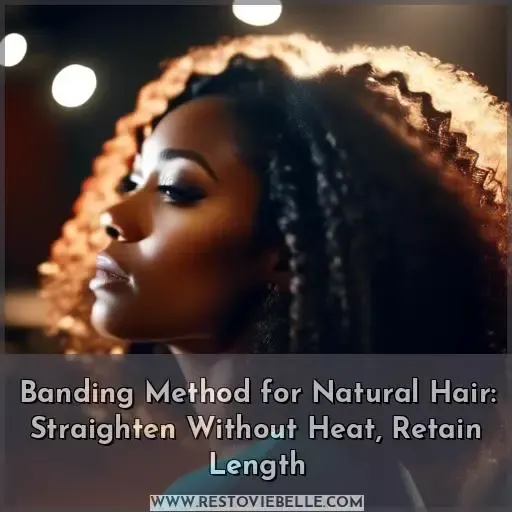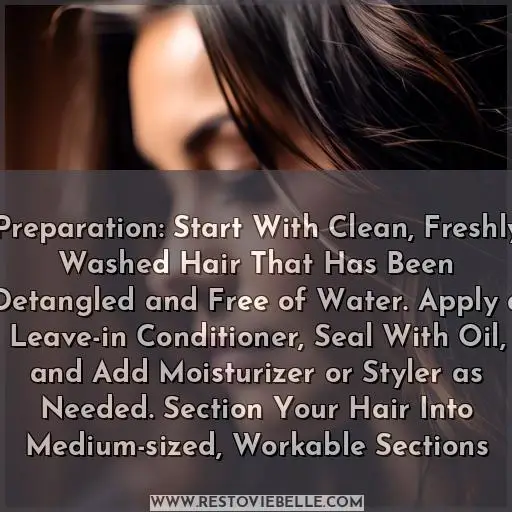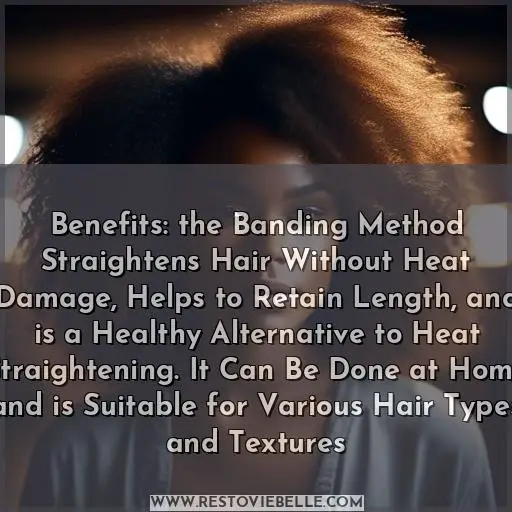This site is supported by our readers. We may earn a commission, at no cost to you, if you purchase through links.
 The banding method for natural hair is a gentle way to straighten your curls without heat damage. You’ll start with freshly washed, detangled hair, applying a leave-in conditioner and oil. Section your hair, then wrap fabric-covered bands from roots to ends. Leave bands in until hair is 90% dry for maximum stretch.
The banding method for natural hair is a gentle way to straighten your curls without heat damage. You’ll start with freshly washed, detangled hair, applying a leave-in conditioner and oil. Section your hair, then wrap fabric-covered bands from roots to ends. Leave bands in until hair is 90% dry for maximum stretch.
This technique helps retain length while achieving sleek, frizz-free results suitable for various textures. It’s a healthy, at-home alternative to heat straightening. If you’re seeking polished curls without compromise, banding offers a simple solution worth exploring further.
Table Of Contents
- Key Takeaways
- Preparation: Start With Clean, Freshly Washed Hair That Has Been Detangled and Free of Water. Apply a Leave-in Conditioner, Seal With Oil, and Add Moisturizer or Styler as Needed. Section Your Hair Into Medium-sized, Workable Sections
- Benefits: the Banding Method Straightens Hair Without Heat Damage, Helps to Retain Length, and is a Healthy Alternative to Heat Straightening. It Can Be Done at Home and is Suitable for Various Hair Types and Textures
- Frequently Asked Questions (FAQs)
- What type of hair ties are best for the banding method?
- How long should I leave the hair ties in for during the banding process?
- Can I band my hair while it’s still wet?
- How do I prevent my hair from tangling during the banding process?
- Can I use different banding techniques to achieve different results?
- Conclusion
Key Takeaways
- The banding method is a heat-free technique for straightening natural hair that also aids in length retention and minimizes the risk of heat damage.
- Proper preparation is crucial, involving starting with clean, detangled, and damp hair, applying a leave-in conditioner, sealing with oil, and using the right hair ties to avoid breakage.
- Timing is important; hair should be banded when it’s about 75% dry and allowed to air dry completely for the best results, with the option to adjust the tightness of the bands for desired curl retention.
- This method is versatile and suitable for various hair types and textures, offering a healthy alternative to heat straightening and allowing for different styling outcomes through experimentation with banding techniques.
Preparation: Start With Clean, Freshly Washed Hair That Has Been Detangled and Free of Water. Apply a Leave-in Conditioner, Seal With Oil, and Add Moisturizer or Styler as Needed. Section Your Hair Into Medium-sized, Workable Sections
To start with, it’s essential to have clean, freshly washed hair that’s free of water. This means your hair should be detangled and ready for styling. Apply a leave-in conditioner to your hair, which will help lock in moisture and protect your hair from damage. Seal your hair with oil and add a moisturizer or styler as needed. Section your hair into medium-sized, workable sections to make the banding process easier. Remember, the size of the sections will depend on the thickness and length of your hair.
When it comes to the banding process, it’s crucial to use hair ties of your choice. Wrap the ponytail holder twice around the base of a section, then move your fingers down an inch and wrap the band around the hair at that section. Continue wrapping the ponytail holder around the length of the section until you reach the end. Blot any excess product to reduce drying time. Repeat this process for all sections of your hair.
It’s essential to wait until your hair is 75% dry before banding. This will help prevent damage and ensure that the banding process is effective. Allow your hair to air dry thoroughly before removing the ponytail holders. If you want more stretch and less curl retention, wrap the hair ties closer along the hair’s length. Remember, larger hair sections take longer to dry, so be patient.
Benefits: the Banding Method Straightens Hair Without Heat Damage, Helps to Retain Length, and is a Healthy Alternative to Heat Straightening. It Can Be Done at Home and is Suitable for Various Hair Types and Textures
The banding method is a great way to straighten your natural hair without causing any heat damage.
Heat Damage Prevention
To prevent heat damage when using the banding method for natural hair, it’s essential to follow a few guidelines.
Avoid banding wet hair as it can lead to breakage and an extended drying time.
Instead, band damp hair that has been freshly washed and detangled.
Apply a leave-in conditioner.
Seal with oil.
Add moisturizer or styler as needed.
Section your hair into medium-sized, workable sections to make the process easier.
Length Retention
The Banding Method is a game-changer for natural hair care. By sectioning your hair into medium-sized, workable sections and using hair ties to gently stretch it as it dries, you can achieve straightened hair without heat damage.
This method also helps retain length by allowing your hair to dry without shrinking.
- Sectioning Technique: Divide your hair into manageable sections before banding to make the process easier.
- Hair Drying Time: Wait until your hair is 75% dry before banding to prevent breakage.
- Curl Retention Level: The level of curl retention depends on how tightly you wrap the hair ties.
Healthy Alternative
Embrace the Banding Method as your go-to healthy alternative to heat straightening.
This technique not only straightens your hair without heat damage but also helps retain length, perfect for those seeking liberation from heat tools.
With a little time commitment, you can achieve hair health that underpins your overall well-being.
Product choice is crucial, so consider scalp sensitivity and hair growth.
Don’t forget the LCO method and moisture mixture to unlock the secrets of healthy, ever-evolving hair.
Frequently Asked Questions (FAQs)
What type of hair ties are best for the banding method?
Opt for soft, fabric-covered bands or scrunchies that won’t snag or rip your strands. Ouchless ribbon hair ties work great too! Avoid anything too tight or rough that could damage your delicate curls.
How long should I leave the hair ties in for during the banding process?
What timing you choose depends entirely on you – leave the bands in until your hair is 90% dry for maximum stretch, but remove them sooner if you prefer more curl definition.
Can I band my hair while it’s still wet?
You’ll get better results by banding slightly damp hair. Sopping wet hair takes forever to dry, increasing the risk of mold or mildew. Let your mane lose some moisture first for faster drying and healthier locks.
How do I prevent my hair from tangling during the banding process?
To avoid tangles during banding, you’ll want to detangle thoroughly before starting. Work in smaller sections, and use plenty of slip from leave-ins or stylers. Gently finger-detangle as you band each section.
Can I use different banding techniques to achieve different results?
Yes, you can absolutely experiment with different banding techniques to achieve various results. From loose waves to straight hair, get creative and find what works best for your unique texture.
Conclusion
While straightening can damage hair, the banding method for natural hair offers a gentle alternative. You’ll retain length, avoid heat, and achieve sleek results at home. With proper preparation and technique, this process suits various textures, delivering a polished look without compromising health. Embrace this simple solution to style your curls frizz-free.







